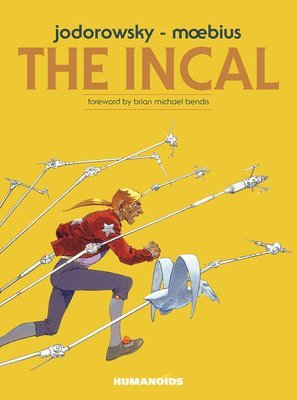
- Format
- Inbunden (Hardback)
- Språk
- Engelska
- Läsålder
- Unga vuxna
- Antal sidor
- 316
- Utgivningsdatum
- 2014-09-24
- Förlag
- Humanoids, Inc
- Illustratör/Fotograf
- Jean Giraud
- Dimensioner
- 270 x 210 x 30 mm
- Vikt
- ISBN
- 9781594650932
- 1290 g
Incal
- Skickas från oss inom 2-5 vardagar.
- Fri frakt över 249 kr för privatkunder i Sverige.
Passar bra ihop
De som köpt den här boken har ofta också köpt Sunrise on the Reaping av Suzanne Collins (inbunden).
Köp båda 2 för 730 krKundrecensioner
Fler böcker av Alejandro Jodorowsky
-
Jodorowsky Library: Book Six
Alejandro Jodorowsky
-
Sons of El Topo Omnibus
Alejandro Jodorowsky
-
Bouncer
Alejandro Jodorowsky
-
Metabarons: The Complete Second Cycle
Alejandro Jodorowsky, Jerry Frissen
Övrig information
Alejandro Jodorowsky Prullansky¿(Spanish:¿[xo¿o'?ofski]; born 17 February 1929) is a Chilean and French¿avant-garde filmmaker. Best known for his films¿El Topo¿(1970),¿The Holy Mountain¿(1973) and¿Santa Sangre¿(1989), Jodorowsky has been "venerated by¿cult cinema¿enthusiasts" for his work which "is filled with violently¿surreal¿images and a hybrid blend of¿mysticism¿and religious provocation".[1] Born to¿Jewish-Ukrainian¿parents in Chile, Jodorowsky experienced an unhappy and alienated childhood, and so immersed himself in reading and writing poetry. Dropping out of college, he became involved in theater and in particular¿mime, working as a clown before founding his own theater troupe, the¿Teatro Mimico, in 1947. Moving to Paris in the early 1950s, Jodorowsky studied traditional mime under¿Étienne Decroux, and put his miming skills to use in the silent film¿Les têtes interverties¿(1957), directed with Saul Gilbert and Ruth Michelly. From 1960 onwards he divided his time between Mexico City and Paris, where he co-founded¿Panic Movement, a surrealist¿performance art¿collective that staged violent and shocking theatrical events. In 1966 he created his first comic strip,¿Anibal 5, and in 1967 he directed his first feature film, the surrealist¿Fando y Lis, which caused a huge scandal in Mexico, eventually being banned. His next film, the¿acid western¿El Topo¿(1970), became a hit on the¿midnight movie¿circuit in the United States, considered the first-ever midnight cult film, and garnered high praise from¿John Lennon, who convinced former¿Beatles¿manager¿Allen Klein¿to provide Jodorowsky with $1¿million to finance his next film. The result was¿The Holy Mountain¿(1973), a surrealist exploration of¿western esotericism. Disagreements with Klein, however, led to both¿The Holy Mountain¿and¿El Topo¿failing to gain widespread distribution, although both became classics on the underground film circuit.[1]¿After¿a cancelled attempt¿at filming¿Frank Herbert's 1965 science fiction novel¿Dune, Jodorowsky produced five more films: the family film¿Tusk¿(1980); the surrealist horror¿Santa Sangre¿(1989); the failed blockbuster¿The Rainbow Thief¿(1990); and the first two films in a planned five-film autobiographical series¿The Dance of Reality¿(2013) and¿Endless Poetry¿(2016). Jodorowsky is also a¿comic book writer, most notably penning the science fiction series¿The Incal¿throughout the 1980s, which has been described as having a claim to be "the best comic book" ever written.[2]¿Other comic books he has written include¿The Technopriests¿and¿Metabarons. Jodorowsky has also extensively written and lectured about his own spiritual system, which he calls "psychomagic" and "psychoshamanism", which borrows from¿alchemy, the¿tarot,¿Zen Buddhism¿and¿shamanism.[3]¿His son Cristóbal has followed his teachings on psychoshamanism; this work is captured in the feature documentary¿Quantum Men, directed by Carlos Serrano Azcona.[4] Jean "M?bius" Giraud was a French artist, cartoonist and writer who worked in the Franco-Belgian bandes dessinées tradition. Giraud garnered worldwide acclaim predominantly under the pseudonym M?bius and to a lesser extent under the name¿Gir, which he used for the Blueberry series and his paintings. M?bius' most famous work was The Incal, written by Alejandro Jodorowsky. He¿also contributed storyboards and concept designs to numerous science fiction and fantasy films, such as Alien, Tron, The Fifth Element and The Abyss.
Du kanske gillar
-
Tummy Time!
Mama Makes Books
Enlarged edition -
Powerful
Lauren Roberts
Trade Paperback -
Powerless
Lauren Roberts
Häftad


